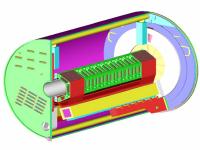
|

|

|

|

| purpose of bits | bit numbers in the substring | bit numbers in the complete string heap manager
| 16
| 1
| heap manager
| ...
| ...
| heap manager
| 1
| 16
| TGV1
| 190
| 17
| TGV1
| ...
| 16 + (191-i)
| TGV1
| 1
| 206
| TGV2
| 190 ... 1
| 207 ... 396
| TGV3
| 190 ... 1
| 397 ... 586
| TGV4
| 190 ... 1
| 587 ... 776
| TGV5
| 190 ... 1
| 777 ... 996
| TGV6
| 190 ... 1
| 997 ... 1156
| TGV7
| 190 ... 1
| 1157 ... 1346
| TGV8
| 190 ... 1
| 1347 ... 1536
| AMU1
| 33
| 1537
| AMU1
| i=32...2
| 1538 ... 1568
| AMU1
| 1
| 1569
| AMU2
| 33 ... 1
| 1570 ... 1602
| AMU3
| 33 ... 1
| 1603 ... 1635
| AMU4
| 33 ... 1
| 1636 ... 1668
| AMU5
| 33 ... 1
| 1669 ... 1701
| AMU6
| 33 ... 1
| 1702 ... 1734
| AMU7
| 33 ... 1
| 1735 ... 1767
| AMU8
| 33 ... 1
| 1768 ... 1800
| |
The table above describes the bits in the order they are described in all documentation written prior to today (1-June-2000). However, if we were to number the bits in the order in which they are sent out, the organization of the serial string (and the programs which manipulate it) would be a little simpler. In addition, because I anticipate using C programs to manipulate these data, I have started all indeces from 0 instead of 1.
| purpose of bits | bit numbers in the substring where 0 = first bit | bit numbers in the complete string where 0 = first bit sent AMU7
| 0 ... 32
| 0 ... 32
| AMU6
| 0 ... 32
| 33 ... 65
| AMU5
| 0 ... 32
| 66 ... 98
| AMU4
| 0 ... 32
| 99 ... 131
| AMU3
| 0 ... 32
| 132 ... 164
| AMU2
| 0 ... 32
| 165 ... 197
| AMU1
| 0 ... 32
| 198 ... 230
| AMU0
| 0 ... 32
| 231 ... 263
| TGV7
| 0 ... 189
| 264 ... 453
| TGV6
| 0 ... 189
| 454 ... 643
| TGV5
| 0 ... 189
| 644 ... 833
| TGV4
| 0 ... 189
| 834 ... 1023
| TGV3
| 0 ... 189
| 1024 ... 1213
| TGV2
| 0 ... 189
| 1214 ... 1403
| TGV1
| 0 ... 189
| 1404 ... 1593
| TGV0
| 0 ... 189
| 1594 ... 1783
| heap manager
| 0 ... 15
| 1784 ... 1799
| |
Summary: